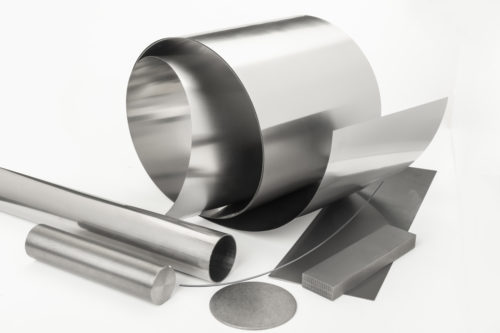Facts About Niobium: Production, Properties, Applications, and Availability
 Niobium – the 41st element on the periodic table– is a soft, grey, crystalline metal used in a variety of applications from steel production to hypoallergenic jewelry. The metal was originally discovered by British chemist Charles Hatchett in 1801 as he examined American minerals from a collection in the British Museum. Hatchett named this element columbium, after Christopher Columbus. Through the years most people now refer to this element as Niobium. As tantalum and niobium are often found together and for many years were indistinguishable from each other, the name niobium comes from Niobe, the daughter of Tantalus from ancient Greek mythology.
Niobium – the 41st element on the periodic table– is a soft, grey, crystalline metal used in a variety of applications from steel production to hypoallergenic jewelry. The metal was originally discovered by British chemist Charles Hatchett in 1801 as he examined American minerals from a collection in the British Museum. Hatchett named this element columbium, after Christopher Columbus. Through the years most people now refer to this element as Niobium. As tantalum and niobium are often found together and for many years were indistinguishable from each other, the name niobium comes from Niobe, the daughter of Tantalus from ancient Greek mythology.
Production
Niobium mineral can be found in niobite, euxenite, pyrochlore, and niobite-tantalite. In pyrochlore niobium is often associated with carbonates. Vast deposits of niobium-rich minerals can be found in Russia, Nigeria, Zaire, Canada, along with the leading producer, Brazil. Annual production is over 50,000 tons of oxide.
Pure niobium is extracted from the mineral by digesting with hydrofluoric acid. The niobium aqueous solution is separated from other compounds by liquid-liquid extraction. The purified niobium is then precipitated from the aqueous solution as niobium hydroxide by an alkaline solution such as ammonia. After calcining the hydroxide is turned into niobium penta-oxide (pentoxide, Nb2O5). The niobium oxide can be converted to the metal form by aluminum thermite reduction. The metal is often further purified in an electron beam (EB) furnace to yield niobium ingots. Mill processes turn the ingot to plate, sheet, tube, and wire. Superconductor grade niobium (RRR 300) has very low impurities, especially gases, and can be made by repeatedly refining the metal in a high vacuum EB furnace.
Properties
Niobium is a lustrous, ductile metal. It features a high melting point (2,477° C), lower density than similar refractory metals, high corrosion resistance (but lower than tantalum), and good cold working properties.
Following is a summary of its properties:
- Element Category — Transition Metals
- Phase — Solid
- Symbol — Nb
- Number — 41
- Density — 8.57 grams per cubic centimeter
- STD Atomic Weight — 92.90638(2) g/mol
- Crystal Structure — Body Centered Cubic
- Melting Temperature — 2750 K, 2477° C, 4491° F
- Boiling Point — 5017 K, 4744° C, 8571° F
- Electrical Resistivity — (0 °C) 152 nΩ·m
- Thermal Conductivity — (300 K) 53.7 W·m−1·K−1
- Thermal Expansion — 7.3 µm/(m·K)
Applications
Industrial uses for niobium stretch as far back as the early 1900s, and more benefits are being discovered and applied for this valuable element as time goes on.
Niobium is most commonly used to create alloys. Even with as little as 0.01% niobium, the strength of steel is markedly improved. These alloys are often found in oil and gas facilities and pipelines. Niobium superalloys, such as nickel niobium, have a demonstrable ability to maintain stability, making them highly desirable in rockets and jet engines as well as land-based turbines in power plants.
Niobium titanium alloys are superconductive under certain low temperature range. These alloys are used to create superconducting magnets used in MRI scanners.
Further uses for niobium alloys include:
- Arc-welding rods for stabilized grades of stainless steel
- Nuclear reactor control rod due to its high temperature and corrosion resistance, and low neutron absorption at cross-section
- Crucibles for synthetic diamond manufacturing
- Sodium vapor lamb, and LCD back lighting
- Jewelry: brilliant colors can be created on niobium surface
- Superconductor, supercollider and particle accelerator using ultra-high purity metals and alloys
- Optical coating and camera lens
- Lithium niobite for wave guide in communications
- Thin film solar cell
Product Availability
Admat offers a range line of pure, alloy, and oxide niobium products including:
Pure Niobium
- Commercial grade
- Reactor grade
- Superconductor grade (RRR300)
Niobium Alloys
- Niobium 1% Zirconium
- Niobium 47% Titanium
- Niobium 50% Titanium
- Niobium 55% Titanium
- Niobium 10% hafnium 1% titanium
Metal and alloy forms
- Flat: plate, sheet, foil, strip
- Round: rod, wire
- Tube
- Billet
- Sputtering target – flat or tube/pipe
Niobium oxides
- Ceramic grade
- Optical grade
- Crystal grade
If you’re interested in discussing how niobium can be used for your application, please feel free to contact our team of experts directly.

